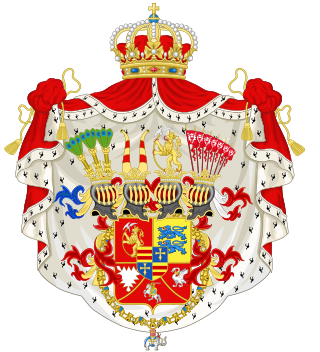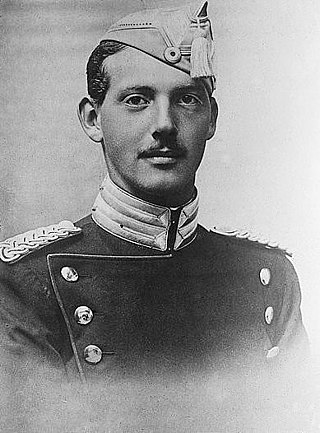
Morganatic marriage, sometimes called a left-handed marriage, is a marriage between people of unequal social rank, which in the context of royalty or other inherited title prevents the principal's position or privileges being passed to the spouse, or any children born of the marriage. The concept is most prevalent in German-speaking territories and countries most influenced by the customs of the German-speaking realms.

The House of Schleswig-Holstein-Sonderburg-Glücksburg, better known as the House of Glücksburg, is a collateral branch of the German House of Oldenburg. Its members have reigned at various times in Denmark, Norway, Sweden, Iceland, Greece, and several northern German states.

Count of Wisborg is a title granted by the monarchs of Luxembourg to some men formerly titled as princes of Sweden and their descendants.

The House of Oldenburg is an ancient dynasty of German origin whose members rule or have ruled in Denmark, Iceland, Greece, Norway, Russia, Sweden, the United Kingdom, Livonia, Schleswig, Holstein, and Oldenburg. The current King of the United Kingdom and King of Norway are agnatic members of this house, meanwhile the King of Spain and King of Denmark are matrilineal members.

The Danish Act of Succession, adopted on 5 June 1953, restricts the throne to those descended from Christian X and his wife, Alexandrine of Mecklenburg-Schwerin, through approved marriages. By a change in the law in 2009, succession is governed by absolute primogeniture.

The Danish royal family is the dynastic family of the monarch of Denmark. While some members of the Danish royal family hold the title of Prince(ss) of Denmark, descendants of Margrethe II additionally bear the title Count(ess) of Monpezat. Children of the monarch are accorded the style of His/Her Royal Highness. The King and Queen are styled Majesty.

Dietrich or Theoderic of Oldenburg was a feudal lord in Northern Germany, holding the counties of Delmenhorst and Oldenburg. He was called "Fortunatus", as he was able to secure Delmenhorst for his branch of the Oldenburgs.

Knud, Hereditary Prince of Denmark was a member of the Danish royal family, the younger son and child of King Christian X and Queen Alexandrine.

The House of Danneskiold-Samsøe is a Danish family of high nobility associated with the Danish Royal Family, and who formerly held the island of Samsø as a fief.

Count Ingolf of Rosenborg is a Danish count and former prince. Born Prince Ingolf of Denmark, he appeared likely to some day become king until the constitution was changed in 1953 to allow females to inherit the crown, placing his branch of the dynasty behind that of his first cousin Princess Margrethe and her two younger sisters. He later gave up his princely rank and his rights to the throne in order to marry a commoner.
Count Christian of Rosenborg was a member of the Danish royal family. Born Prince Christian of Denmark, from 1947 he was third in the line of line of succession until the constitution was changed in 1953 to allow females to inherit the crown, placing his branch of the dynasty behind that of his cousin Margrethe and her two younger sisters. He later gave up his princely rank and his rights to the throne in order to marry a commoner.

Prince Georg of Denmark was a Danish diplomat and member of the Danish royal family as a great-grandson of Christian IX. He was a first cousin of Harald V of Norway, Baudouin of Belgium, and Albert II of Belgium, as well as a second cousin of George VI of the United Kingdom.

Princess Caroline-Mathilde of Denmark was a daughter of Prince Harald of Denmark and granddaughter of King Frederik VIII of Denmark. As the wife of Knud, Hereditary Prince of Denmark, she became Hereditary Princess of Denmark.

Prince Aage, Count of Rosenborg, was a Danish prince and officer of the French Foreign Legion. He was born in Copenhagen the eldest child and son of Prince Valdemar of Denmark and Princess Marie d'Orléans.

Prince Viggo, Count of Rosenborg was a Danish prince. He was born in Copenhagen the youngest son of Prince Valdemar of Denmark and Princess Marie of Orléans. He was also the youngest grandson of Christian IX of Denmark.

Prince Erik, Count of Rosenborg was a Danish prince. He was born in Copenhagen, a son of Prince Valdemar of Denmark and Princess Marie of Orléans.

The monarchy of Denmark is a constitutional institution and a historic office of the Kingdom of Denmark. The Kingdom includes Denmark proper and the autonomous territories of the Faroe Islands and Greenland. The Kingdom of Denmark was already consolidated in the 8th century, whose rulers are consistently referred to in Frankish sources as "kings". Under the rule of King Gudfred in 804 the Kingdom may have included all the major provinces of medieval Denmark.

The House of Monpezat is a French old bourgeois family from the province of Béarn associated with the Danish royal family by marriage after 1967, when Henri de Laborde de Monpezat wed Princess Margrethe of Denmark, then the heir presumptive of the ruling House of Glücksburg, who was subsequently the Queen of Denmark as Margrethe II. The current Danish monarch, King Frederik X is agnatically a Laborde de Monpezat.

Count of Monpezat, or Countess of Monpezat when the holder is female, is a hereditary title of Danish nobility. It was granted on 30 April 2008 by Queen Margrethe II to her two sons, Crown Prince Frederik and Prince Joachim, and their legitimate patrilineal (male-line) descendants of both sexes. The title is derived from the French title of "comte de Laborde de Monpezat", which was used by Frederik and Joachim's father, Prince Henrik.


















